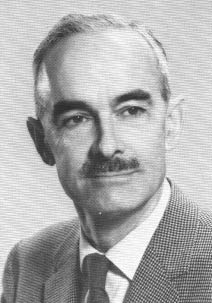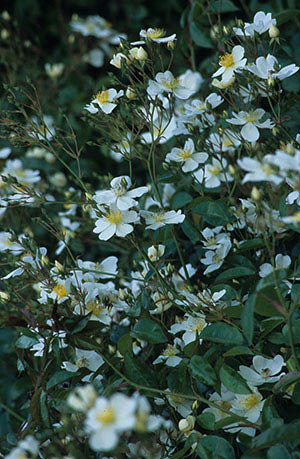
Brian O. Mulligan was born in 1907 in Marino, County Down, just north of Belfast, Ireland. He was educated at the Royal Horticultural Society garden at Wisley, England, with advanced work at the University of Bristol Agricultural and Horticultural Research Station.
While at Wisley, Mulligan discovered and introduced a woody ground cover that was a spontaneous hybrid between two of the garden’s cultivated plants. This new plant, now known as Gaultheria x wisleyensis ‘Wisley Pearl’, has become an important landscape plant. Salal, one of the parents of this cross, is an important native plant found today throughout the Arboretum.
While working in the plant collections at Wisley, Mulligan also identified a new fragrant white rose, which was cultivated from a seed that had been collected by famed Scottish plant explorer George Forrest in China. In recognition of his skill at identifying this rose as a new species, the Belgian botanist G.A. Boulenger later named Mulligan’s find Rosa mulliganii in his honor. Mulligan’s research and commitment to the field earned him a position as assistant to the director at Wisley.
Perhaps it was his experience at Wisley that helped Mulligan to realize that a scientifically arranged garden and botanical collection was a perfect venue for botanical research. This experience would inform the rest of his career.
Mulligan met his wife Margaret while studying at Wisley. He offered to show her around the winter garden. An active gardener herself, Margaret accepted his offer, though she wondered what could be interesting about walking through a garden in the dead of winter. Their stroll revealed beautiful blooms of heather and witch hazel.
During World War II, Mulligan served two years in the Royal Air Force. In 1943, he became one of seven horticultural advisers on vegetable growing at Royal Air Force stations throughout Great Britain. In this capacity, he ran the United Kingdom’s version of a Victory Garden program. Donald Graham, a friend of the Arboretum and member of the Arboretum Foundation, was posted in England during the war. He visited some of Mulligan’s gardens and upon his return to the States, recommended Mulligan as the director of the Arboretum. Lord Aberconway, President of the Royal Horticultural Society, wrote a letter of recommendation stating, “Your gain would be our loss. He is one of the most outstanding persons I know of with the qualifications for the position you mention.”
In 1946, Brian Mulligan accepted the position of Director of the Arboretum. The starting salary for the position was $300 per month plus lodging in the stone cottage at the south entrance of the Arboretum. He and his wife arrived in Seattle in October of that year.

Under the direction of Brian Mulligan, the Arboretum flourished. One of the first things Mulligan did after becoming director of the Arboretum was relocate vast numbers of specimens in the collection to places that were better suited to their specific environmental needs. As a result, trees that once struggled began to thrive. He also participated in many seed exchanges around the world that added significantly to the holdings of the Arboretum.
In addition to his work at the Arboretum, Mulligan also served as President of the American Association of Botanical Gardens and Arboreta as well as Vice President of the Royal Horticultural Society, the International Dendrology Society and the American Rock Garden Society.
Through the course of his career, Mulligan received many awards for his contributions to botany and horticulture. His awards included the Veitch Memorial Gold Medal from the Royal Horticultural Society, the Gold Medal of the Massachusetts Horticultural Society and the Award of Merit of the American Association of Botanical Gardens and Arboreta.
Mulligan was the director of the Arboretum until his retirement in 1972. After retiring, he remained devoted to the Arboretum as Director Emeritus and volunteered until his death in 1996.
